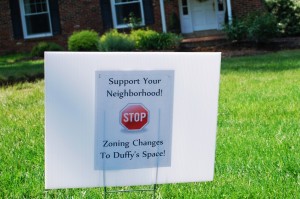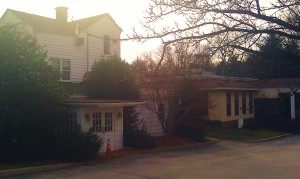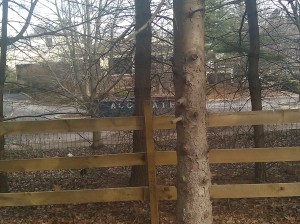This is a follow-up to an earlier post, Jimmy Duffy’s Redevelopment Plan Requires Zoning Change … Is There Community Support?
Last week’s town hall meeting included an update on the redevelopment project from developer Ed Morris, who was accompanied by Capital Health Group, LLC representative Gerard Farrell and their attorney Denise Yarnoff of Riley Riper Hollin & Colagreco. In addition to members of the Daylesford Neighborhood Association (DNA) was Mimi Gleason, township manager and Matt Bauman, township zoning officer, 3 supervisors (JD DiBuonaventuro, Michelle Kichline and Kristen Mayock) and 3 Planning Commissioners (Bob O’Leary, Tory Synder and Trip Lukens).
Perhaps the intentions of the meeting were good but overall, I found the meeting less than satisfactory as an audience member. Having attended the 2 planning commission meetings (September, October 2011), 2012 January Board of Supervisors meeting and developer-DNA public meeting this past February (where this project was discussed), I expected that this latest meeting would give local residents an opportunity to really be ‘heard’ by those representing our government, in addition to an update from the developer. I did not leave the meeting feel that mission was accomplished.
The discussion surrounding the Jimmy Duffy project is confusing … on one hand, there has been no formal land development plan presented to the township by Capital Health. (Currently, the C-1 and R-1 zoning of the Duffy property does not allow for an assisted living facility.) Yet, on the other hand, based on the number of meetings and input from planning commissioners, supervisors and township staff, suggests that this project has advanced beyond a vague, casual stage.
Eagle Bank owns the Jimmy Duffy property and with the current economic climate, I’m guessing may be willing to sell it for a significantly reduced price. However, a developer probably would not want to purchase the property unless there was a degree of assurance that the deal would go through so … he/she would be looking for ‘buy-in’ to the project from the community and the local government; hence the visits to and discussions with, the planning commissioners.
However, here’s the ‘dicey’ part for me and what I do not understand. Although Ed Morris has made concessions in his latest draft drawings of his project (one less floor, more trees, etc) he still has the problem that the current zoning does not permit this usage of the property. Current zoning only permits assisted living in the Industrial Overlay district and that has a 10 acre minimum requirement. As I understand township zoning, an applicant would need to take his land development plan to the Zoning Hearing Board and seek a variance to build the project on the 2-acre Duffy site. But rather than taking the variance route, the discussion has evolved to Ed Morris writing an amendment to the current C-1 zoning ordinance to include assisted living as an acceptable use. Although I have been told that it is a normal, and acceptable practice, for a developer to draft zoning ordinance language, it certainly appears odd and rather self-serving to me. But I certainly do not claim to be a zoning or planning expert!
Former township supervisor and Zoning Hearing Board member John Petersen weighs in with his opinion on the Jimmy Duffy redevelopment project. He has submitted the following op-ed article, ‘Why the contemplated development at the old Duffy Catering site is a bad idea’ to Main Line Media News for publication:
Why the contemplated development at the old Duffy’s Catering site is a bad idea
This critique has nothing to do with the project’s underlying merits. It may very well be that an assisted living use may be a good idea on the 2 acre site in spite of the fact that such a use is currently only permitted on a 10+ acre parcels. Rather, this critique has to do with the process and procedure surrounding the Tredyffrin Township Board of Supervisors (BOS) and Planning Commission’s (PC) apparently affinity to abandon established process and procedures in favor of fast-tracking said project on said site. To fast track the development, the BOS and PC are considering the drastic step of adding assisted living as an approved use in the C1 zoning district. There are 3 basic and simple reasons why the BOS and PC are yet again, showing an astonishing lack of judgment.
1. The project developer, already has a remedy that has not been exhausted
The developer has not applied for a variance from the Zoning Hearing Board (ZHB). A zoning variance allows for a use or condition that exists outside the current zoning regulations. If the ZHB were to grant a variance, a wholesale change to zoning would not be required. The benefit is that the change applies only the specific parcel and can be tailored to only apply to current owner. When asked about a variance, developer’s counsel replied “That would take too long.” I used to sit on the BOS and the ZHB and I don’t recall “Taking too long” as being a bona-fide reason to abandon procedure. It’s also been reported that the township’s zoning officer kept “deferring” to applicant’s counsel. That is highly irregular. In effect, applicant’s counsel is dictating and driving procedure, and in this case, changing it for the benefit of the developer. It is certainly to the developer’s benefit to have the zoning changed since that would obviate the need to seek a variance. As one supervisor pointed out at the town hall meeting “It’s not the BOS’s job to seek out projects.” Yet, that is exactly what is happening here. At the very least, this project sought out this BOS and PC. Regardless of how they found each other, the BOS and PC seem ready, willing and able to give this specific developer, this specific project and this specific parcel of land special treatment. This sets a dangerous precedent.2. The BOS just committed to spend $100K on a review of its ZO
Some would point out that grant money makes the net cost only $30K. However, those grants are not guaranteed. The only thing that is guaranteed is the $100K consulting appropriation. Only when and if the revised zoning, based on the consultant’s recommendations are approved, do the grants have the potential to be realized. Once the BOS committed to having the ZO reviewed, a moratorium on zoning changes should have been established. What if this contemplated new use in C1 is deemed to be a less than optimal use? It appears foolish to tweak something that is about to undergo a comprehensive and expensive review.3. The process and procedure (or lack thereof) sets a precedent for future developers and projects
The BOS and PC might as well put a large for sale sign on the township. Consider the next developer who seeks to develop a C1 parcel or perhaps a residential or industrial parcel with a use that is not contemplated under the ZO. What are the BOS and PC going to say then? No? That developer may have a very good case to take to court. Zoning must be non-prejudicial. It must be a-political. Zoning represents 50-100 year decisions. These are long term in nature. The costs of making wrong decisions are high. We are already dealing with storm water problems in the township that are due, in part, to bad planning. Good planning begins with a vision that is independent of any specific project. The goal is to have consistent and compatible uses that meet the divergent needs of residents and businesses (retail, commercial and sometimes industrial). You don’t begin with specific projects and let the model shake out from there. We have a zoning map that will now undergo review based on the results of the 2009 Comprehensive Plan Process. At the same time, a new use will be added to C1. And very likely, there will be another parcel in the township that this developer or another developer will seek to develop for another non-permitted use? Based on this precedent, the BOS will be obliged to say yes because the BOS cannot and has not offered a single articulable rational basis for this decision. And let’s not forget that there are no plans in front of the PC. How can this possibly be contemplated now? How is this not favoritism – the problem encountered with spot-zoning?Conclusion
The 3 aforementioned reasons make it clear that the contemplated actions of the BOS and PC are not in the best interest of this community because the actions represent a departure from established procedures. The actions do not represent what could be considered best-practices insofar as zoning and land use procedure is concerned. Any developer should first submit plans to the PC and where necessary, seek a variance. As a record proceeding, citizens have an opportunity to be present and heard. If that variance is granted, the citizens at least have legal recourse to have such a decision reviewed by the Court. If the variance is denied, then the developer can then seek to have the use added. In that event, the BOS and PC have the benefit of the ZHB proceedings to make a better, more informed decision.In a civilized society, the ends rarely, if ever, justify the means – especially in the case when there are the means to do things the right way – within the framework of existing policies and procedures.
John V. Petersen
Paoli, PA


